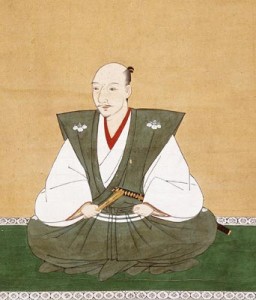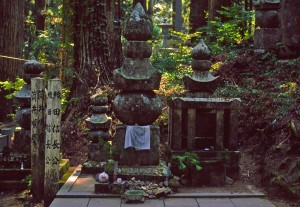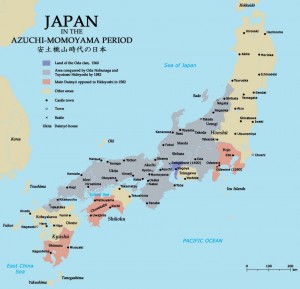| Oda Nobunaga | |
|---|---|
 |
|
| Japanese Warlord | |
| In Power | 1551-1582 |
| Born | June 23, 1534 Owari Province |
| Died | June 21, 1582 Kyoto |
| Nationality | Japanese |
| Rank | Udaijin |
Oda Nobunaga was born in 1534, when Japan was still a fractured country. Small territories were ruled by powerful local warlords who were frequently at war with each other. However, by Nobunaga’s death in 1582, Japan was not far from being completely unified. Unification was completed in the years after Nobunaga’s death by the daimyos Toyotomi Hideyoshi and Tokugawa Ieyasu.
Oda Nobunaga was born during a time that is known as the “The Warring Period,” or the “Sengoku Jidai.” This era lasted almost 200 years, beginning in the mid 1400s and lasting until the early 1600s. It was a time of social upheaval, perpetual warfare, and intense political intrigue.
Beginnings
Oda Nobuaga was the son of the minor noble and warlord, Oda Nobuhide. He was also an important government official of the Owari Province, a portion of land near the mid-south of the main island of Japan. Owari was divided into eight districts, and Nobuhide ruled only one of them. As a warlord, Nobuhide spent his life in a constant military struggle against neighboring provinces and clans. He died unexpectedly in 1551 when Oda Nobunaga was about 16 years old.
Bizarre Behavior
Earlier in life, Nobunaga’s peculiar behavior and conduct often made his peers doubt him. He earned the nickname of “Owari no Outsuke,” which translates to “The Fool of Owari.” He seemed to have contempt for tradition and keeping place in society. Although he was a noble of a powerful house, he associated with commoners, peasants, and the lowly.
At his father’s funeral, Nobunaga acted in a bizarre and inexplicable way. In a society where observing ancient rituals and strict protocols was of extraordinary importance, Nobunaga displayed shocking acts of sacrilege such as throwing ceremonial incense at the altar. His behavior turned some of his retainers against him and caused dispute among the family.
After Nobunaga’s behavior at his father’s funeral, a man who was close to him committed ritual suicide (seppuku). His motivation was the shame and disapproval of Nobunaga’s antics, especially the desecration of his father’s funeral. The man was named Hirate Masahide, a samurai of great honor in service to the Oda clan. The effect of Hirate Masahide’s suicide on Nobunaga was profound and he later built a temple to his memory.
Struggle for Power
Immediately upon the death of his father, Oda Nobunaga was forced to struggle for power within his own sector of Owari, and to retain his rightful place as head of the Oda clan. By birthright, he should have taken over leadership from his father, but his uncle, Oda Nobutomo, claimed the position for himself. Nobunaga was able to overcome this challenge by enlisting aid and support from another uncle. Together, they killed Oda Nobutomo.
Nobunaga also faced a significant challenge from his younger brother, Nobuyuki, who aligned himself with rival powers in other states. The struggle between Nobunaga and his brother persisted for years but, in the end, Nobunaga killed his brother and solidified his control over the Oda Clan.
Major Wars and Challenges
One of Nobunaga’s primary enemies was the Imagawa clan which was based in the Suruga Province and led by Imagawa Yoshimoto.
In 1560, Imagawa Yoshimoto raised a massive army of 25,000 men and marched toward Owari. This force was made even larger by reinforcements from the Matsudaira clan. These armies amassed at the border realms of the Oda Clan holdings in Owari. Nobunaga is said to have had a mere 3,000 men at his command to protect his land.
Despite the difference in numbers, Nobunaga decided to attack. This course of action was undertaken against the advice of his advisors, who strongly urged him to remain in a defensive position, or to surrender without a fight. Instead, Nobunaga engineered a surprise attack against the Imagawa soldiers. The Oda forces assembled a number of stuffed dummies and placed them in key position where the Imagawa forces could see them, giving the impression that Nobunaga had significant manpower in the field.
In the meantime, Nobunaga maneuvered his men to attack the Imagawa army where it was encamped in a narrow gorge. After a fierce thunderstorm, the Oda clansmen descended upon their enemy, taking them by surprise and defeating them.
This victory greatly increased Nobunaga’s power and, just as importantly, weakened his enemies. Not only did he defeat the Imagawa, but the further result was a breakdown in alliances among that clan and others who were aligned against Nobunaga.
The Aggressor
Next, Nobunaga turned his ambitions of conquest on the Saito clan of Mino province. This effort was made easier when Saito Tatsuoki gained power after the death of his father. Tatsuoki was known to be a weak and ineffectual ruler, and Nobunaga immediately took advantage of the situation. After the famous Siege of Inabayama Castle in 1567, the Saito clan fell, and Nobunaga gained a larger area of Japan.
Oda Nobunaga continued his relentless campaign, swallowing up province after province and pacifying clan after clan, bringing them all under his rule. He adopted the personal seal, “Tenka Fubu,” which means, “All the world by force of arms.”
In addition to military conquest, Nobunaga also relied on his considerable political skills and powers of persuasion to make alliances with other clans as he marched across Japan.
Death
 Although Nobunaga died before he saw all of Japan unified, he had secured about half the provinces of Japan under one shogunate. His death is a point of controversy among many historians. Most think he committed seppuku after being betrayed by Akechi Mitsuhide. In some accounts Mitsuhide organized a coup to usurp power from Nobunaga. A force of men was sent to attack Nobunaga when they knew he would not be well protected. Nobunaga took his own life before he could be captured and humiliated. Other accounts say Nobunaga was killed fighting the forces in the coup attempt.
Although Nobunaga died before he saw all of Japan unified, he had secured about half the provinces of Japan under one shogunate. His death is a point of controversy among many historians. Most think he committed seppuku after being betrayed by Akechi Mitsuhide. In some accounts Mitsuhide organized a coup to usurp power from Nobunaga. A force of men was sent to attack Nobunaga when they knew he would not be well protected. Nobunaga took his own life before he could be captured and humiliated. Other accounts say Nobunaga was killed fighting the forces in the coup attempt.
Legacy
Whatever the cause of death, Oda Nobunaga is certainly one of Japan’s most important historical figures. His drive to unite Japan, although it was bloody, began the process of ending the petty wars of Japanese feudalism. A new era was established and remained in power for two centuries.
